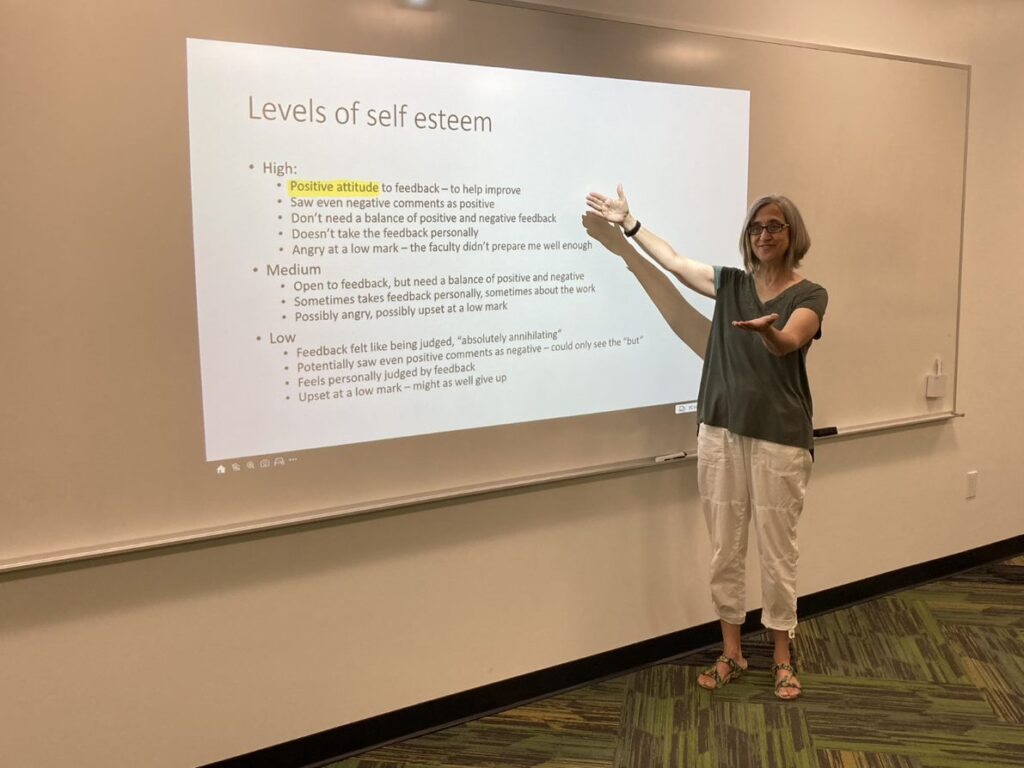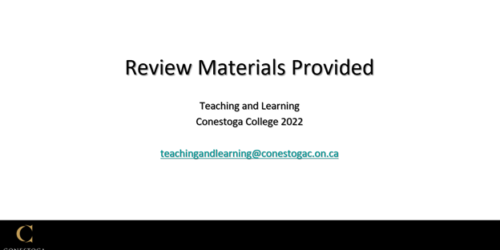Teaching In Person: Delivery Skills
As you prepare to teach an in-person class, it is important to take stock of your tools for teaching. This includes the space, the technology, and you!
This tip will provide suggestions for combining space, technology, and your own presence to help capture and hold your students’ attention.
1. Establish focus from the beginning – share the agenda.
A brief agenda in a visible space on the whiteboard will help keep students engaged as they can follow along the course of the lesson.
2. Establish eye contact.

Post-secondary students “perceive eye contact as a source for motivation, concentration, enthusiasm and a tool for taking and maintaining attention” (Zeki, 2009, p. 1449). Take care to position yourself in the classroom so that you can gesture toward visual Information you are presenting while making eye contact with students. Especially in a large classroom, rather than standing exclusively in one place, you can alternate speaking to the information on the screen from each side of the classroom at different points in the lesson. The students on the side where you are standing will benefit from your proximity. The students on the opposite side of the room will benefit from your eye contact as you position yourself to be able to see the student in the farthest corner of the room from you.
Use the space of a large or long room to position yourself in different parts of the room at various times, so that you can provide proximity to everyone while maintaining eye contact with the whole group.
3. Project your voice.
You can improve voice projection through maintaining a speaking posture which assists breathing. This includes “comfortable stance, relaxed shoulders, and evenly distributed body weight.” Try “elevating the chin, relaxing the neck and lower jaw, and opening the passageways into the throat, mouth, and nose” to improve the resonance of your voice, thus increasing projection. (Jeffers & Underwood, 1993).
4. Articulate clearly.
To project your message to the whole class, say your words clearly and precisely, blend your words together a little less than you usually do, slow down somewhat, and pause between phrases and sentences, stressing key words. (Oticon, 2020; Pourret et al., 2020; Schafer et al., 2021). Challenges with clarity? Contact us and a consultant can work with you.
5. Use gestures to augment the message and hold attention.
Hand and arm gestures are an integral part of how sighted humans communicate, and they play a central role in teaching and learning (Roth, 2001; McNeill, 2005). As you place yourself in a position to see and be seen by the whole class, your gestures can augment visual course materials to maintain student attention and focus on key meanings.
6. Make active learning an integral part of your lesson plan.
Opportunities to work in partners or small groups to solve problems, discuss case studies, or other active learning activities will vary the pace of the class and provide you with the opportunity to circulate and make a connection with students in a smaller group setting. This can help maintain attention and focus when you move back to an all-class presentation segment of the lesson.
Would you like to practice your delivery skills? Make an appointment with a Teaching and Learning Consultant at teachingandlearning@conestogac.on.ca
References
Jeffers, J., & Underwood, G. D. (1993). Enhancing presentation dynamics through voice projection. The Journal of Continuing Education in Nursing, 24(5), 234-237. Retrieved from http://ra.ocls.ca/ra/login.aspx
McNeill, D. (2005). Gesture and Thought. University of Chicago Press.
Oticon. (2020). Communication is a two-way street: Better Communication Habits: A Guide for Family and Friends. https://wdh02.azureedge.net/-/media/oticon-us/main/download-center—myoticon—product-literature/consumer-library/15500-2068—communication-is-a-two-way-street—alliance-brochure—2020.pdf?la=en&rev=47F7&hash=B72BA434761B93DA3BDD8D66A4AE932D#:~:text=Communication%20is%20a%20two%20way%20street.&text=Communication%20is%20the%20key%20to,hearing%20loss%20can%20function%20today.
Pourret, O., & Saillet, E. (2020). Wear your mask, but think about deaf students. Nature, 586(7830), 629–630.
Roth, W.-M. (2001). Gestures: Their role in teaching and learning. Review of Educational Research, 71(3), 365–392. https://doi.org/10.3102/00346543071003365
Schafer, E. C., Dunn, A., & Lavi, A. (2021). Educational challenges during the pandemic for students who have hearing loss. Language, Speech, and Hearing Services in Schools, 52(3), 889–898. https://doi-org.conestoga.idm.oclc.org/10.1044/2021_LSHSS-21-00027
Zeki, C. P. (2009). The importance of non-verbal communication in classroom management. Procedia – Social and Behavioral Sciences, 1(1), 1443–1449. https://doi.org/10.1016/j.sbspro.2009.01.254



